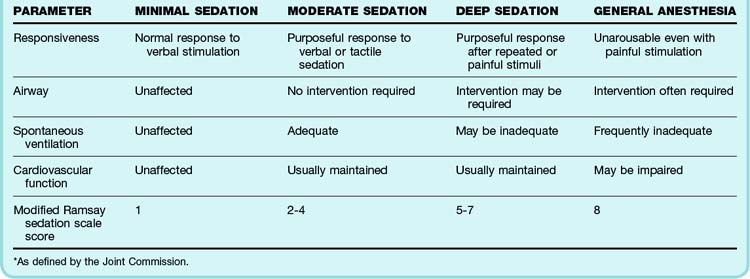10 Procedural Sedation
• Procedural sedation refers to the technique of administering sedatives or dissociative agents with or without analgesics to induce a state that allows the patient to tolerate unpleasant procedures while maintaining cardiorespiratory function.1,2
• Procedural sedation with analgesia in the emergency department is generally intended to create a depressed level of consciousness that allows the patient to maintain control of the airway and oxygenation without continuous assistance.
• Patients must be assessed before sedation to proactively identify potential difficulties associated with disease states and airway maintenance.
• When drugs are used in combination, their effects are more than additive, and this can be beneficial or can potentiate respiratory depression and cardiovascular instability.
• In patients with liver disease, the metabolism of drugs is altered in many ways and it is difficult to predict effects.
• In patients with a recent history of opiate and benzodiazepine overuse, propofol may offer advantages over other agents.
Definitions
Procedural sedation, not including dissociative agents, represents a continuum of sedation ranging across defined levels of consciousness. These varying degrees of awareness have been termed minimal sedation (anxiolysis), moderate sedation, deep sedation, and general anesthesia. See Table 10.1 for general definitions as defined by the Joint Commission. Because patients can move from one state or level of awareness to another without warning, serial assessment and close hemodynamic monitoring are advised.
Indications for Procedural Sedation and Analgesia in the Emergency Department
Patients often arrive at the emergency department (ED) with acute injuries or disorders that require timely intervention to reduce both the physical and the psychologic effects of pain, anxiety, disability, and life-threatening complications. Common indications that may require procedural sedation are listed in Box 10.1.
Patient Monitoring
Because individual patient responses to sedatives and analgesics often vary, constant monitoring is essential to identify subtle changes in respiratory effort and hemodynamics. American College of Emergency Physician guidelines re-commend that patients selected for procedural sedation and analgesia (PSA) undergo continuous cardiac monitoring, continuous pulse oximetry, and documented blood pressure checks every 5 minutes during the procedure and in the postprocedural period.2 Box 10.2 provides a list of objective physiologic parameters recommended for safe bedside monitoring. In addition, see Table 10.2 for the six-point Ramsay sedation scale, which was initially validated in intensive care units for the assessment of sedation depth and later modified to correlate with the Joint Commission definitions of sedation.
Table 10.2 Ramsay Sedation Scale
| CLINICAL SCORE | LEVEL OF SEDATION ACHIEVED |
|---|---|
| 1 | Patient agitated, anxious |
| 2 | Patient cooperative, oriented, and tranquil |
| 3 | Patient responds to commands only |
| 4 | Brief response to light glabellar stimuli or loud auditory stimuli |
| 5 | Sluggish response to light glabellar tap or loud auditory stimuli |
| 6 | No response to light glabellar tap or loud auditory stimuli |
Capnometry (End-Tidal Carbon Dioxide Monitoring)
Many PSA agents decrease tidal volume and the respiratory rate, thereby creating the potential for hypoventilation and apnea. In the majority of patients, pulse oximetry readings correlate well with arterial O2 saturation values. Unfortunately, oximetry is ineffective in the early detection of hyperventilation-induced hypercapnia, particularly if patients are receiving supplemental oxygen. Growing evidence for the routine use of continuous capnography during procedural sedation has led to its increased clinical use in an attempt to identify hypoventilation and avoid unrecognized periods of apnea.2 This monitoring technology may have its greatest benefit in patients whose ventilation status cannot be visualized (e.g., covered with a sterile sheet). Although clear evidence demonstrating differences in clinical outcomes with its use is not yet available, end-tidal CO2 monitoring is probably useful in providing an added level of safety when perform-ing PSA.









